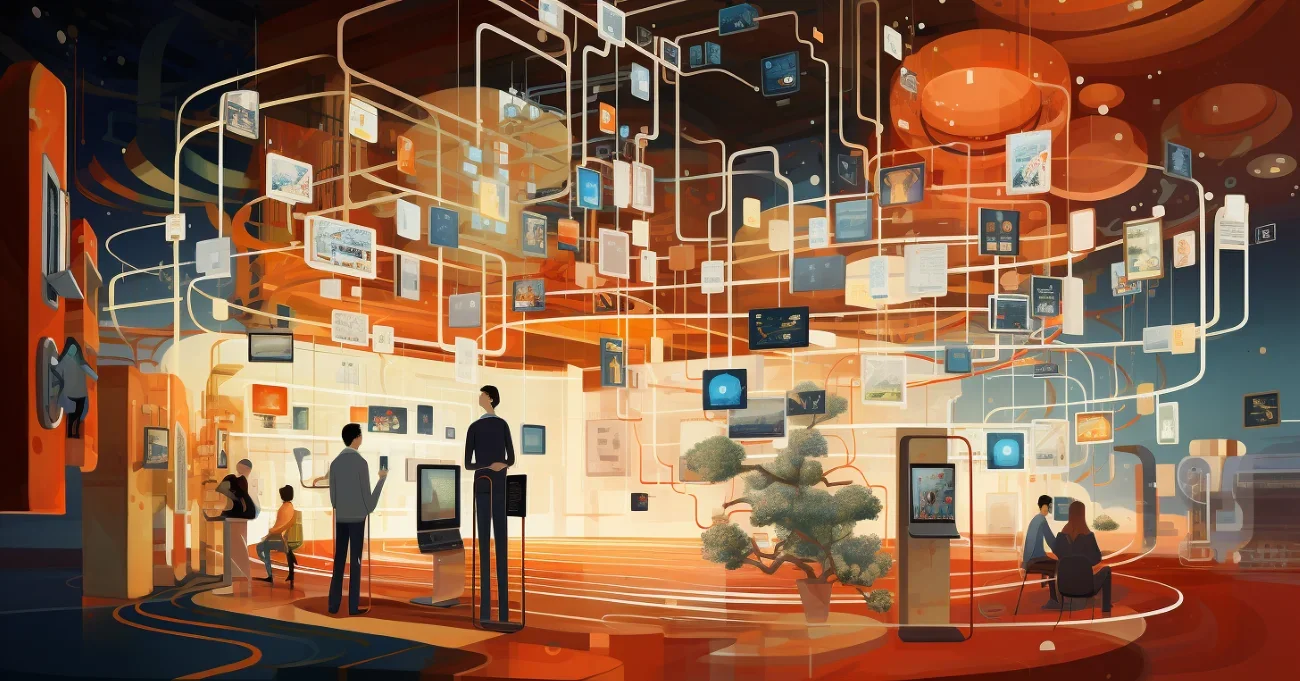The Internet of Things (IoT) stands out for its ability to revolutionize how we interact with technology. Central to this revolution is the IoT platform, which plays a pivotal role in integrating diverse devices and systems. These platforms ensure seamless device management, data collection, and processing, enabling IoT devices to work harmoniously across various sectors.
Aloa, an expert in software outsourcing, understands the significance of IoT software platforms for software development and startups. Leveraging its profound expertise in emerging technologies, Aloa provides cutting-edge solutions that cater to the growing needs of IoT applications. Aloa’s approach to product development encompasses a broad spectrum of IoT components, including device data management, IoT cloud platforms, and IoT analytics.
This blog offers a comprehensive overview of the IoT platform, exploring its use cases, features, and benefits. We will also delve into the types of IoT software platforms, the basic architecture, and the steps for building an IoT platform. Afterward, you'll gain insights into effective IoT product development, from conceptualization to deployment, ensuring scalability, enhanced customer experience, and optimized asset tracking.
Let's begin!
What is an IoT Platform?
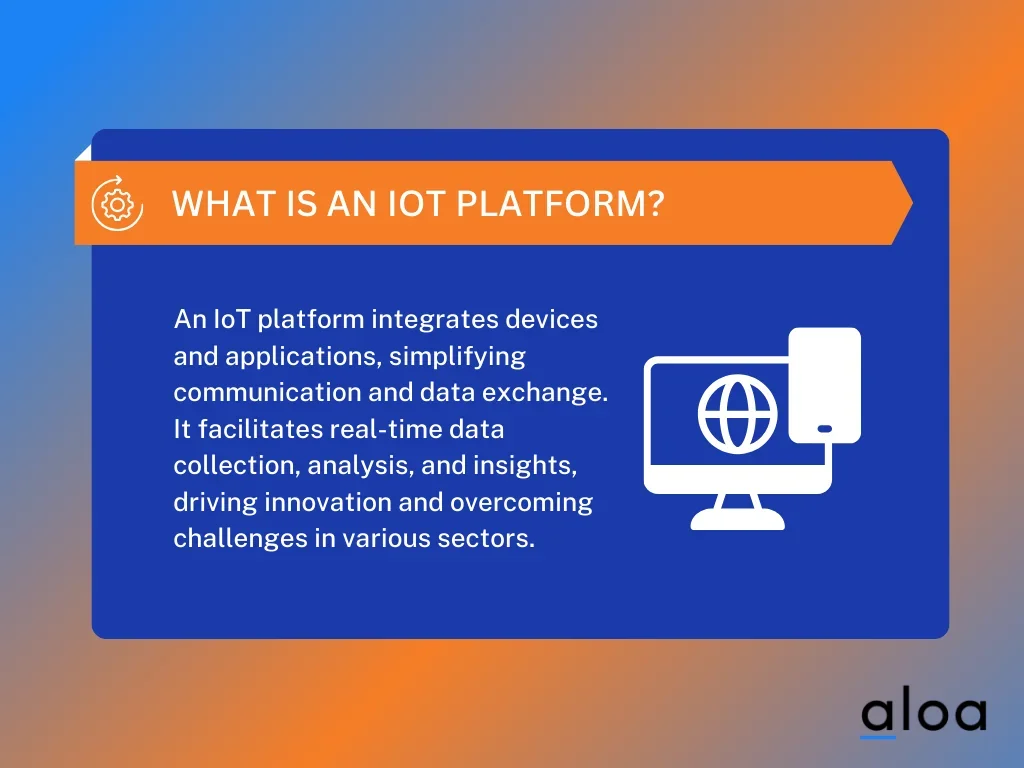
An IoT platform is a framework for integrating various devices and applications over the Internet. It simplifies connecting sensors, devices, and software, enabling seamless communication and data exchange. Offering a unified approach to device management, data processing, and application development ensures that all components work together efficiently.
The IoT platform connects diverse devices and facilitates real-time data collection, analysis, and actionable insights. They are essential in harnessing the power of IoT data, driving healthcare innovations with IoT trends and devices, optimizing real estate management, and overcoming IoT challenges. IoT software platforms enhance data analytics and visualization by leveraging big data, cloud services, and machine learning, ensuring remote monitoring and control.
Types of IoT Platforms
The IoT platform is the backbone, enabling seamless interaction between hardware, software, and the end-user. These platforms are complex ecosystems comprising various components, each catering to distinct facets of IoT systems. Understanding the different types of IoT software platforms is crucial for development teams and IoT experts aiming to harness the full potential of IoT solutions. Let's dive into the different types of IoT platforms below.
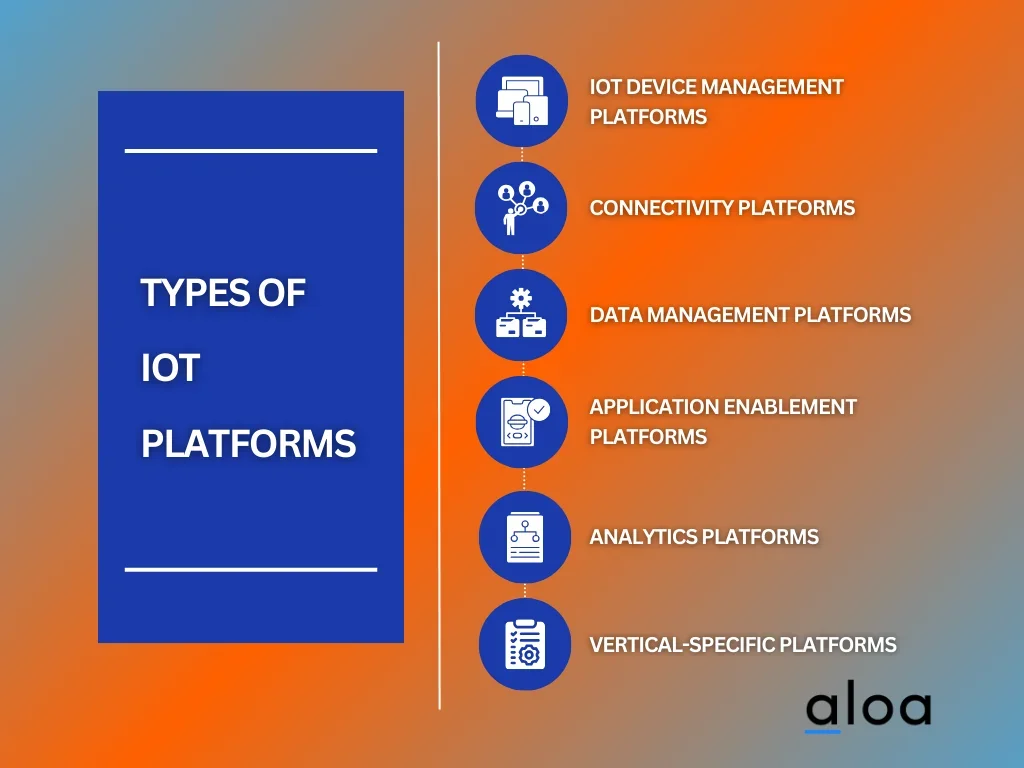
IoT Device Management Platforms
IoT device management platforms focus on the operational aspect of IoT devices, including provisioning, maintenance, and firmware updates. These platforms are essential for ensuring the smooth operation of devices in the field, managing everything from microcontrollers to complex sensors. IoT device management platforms offer a centralized console for overseeing device functionality, making it easier for teams to maintain the health and performance of their IoT ecosystem.
Connectivity Platforms
Connectivity is at the heart of any IoT solution, and connectivity platforms specialize in linking IoT devices to the Internet. They handle protocols such as MQTT, HTTP, and CoAP, ensuring devices can securely and efficiently transmit data to the cloud or other devices. Google IoT Core and Amazon's AWS IoT are prime examples, offering robust frameworks for managing IoT cloud connect services and facilitating communication between devices and cloud applications.
Data Management Platforms
With the vast amounts of data generated by IoT sensors, data management platforms play a pivotal role in organizing, storing, and retrieving this information. These platforms ensure that data is stored securely and is readily accessible for analysis. They support both structured and unstructured data, accommodating the diverse nature of IoT-generated data. Azure and IBM Watson IoT are notable platforms offering comprehensive data storage and management solutions tailored for IoT applications.
Application Enablement Platforms
Application enablement platforms provide a development framework or integrated development environment (IDE) that simplifies the creation of IoT applications. They offer tools and libraries that help developers integrate data visualization, device control, and user management into their IoT solutions. Salesforce IoT Cloud and ThingsBoard are examples where developers can leverage pre-built modules and APIs to accelerate the development of IoT apps, focusing on the application logic rather than the underlying infrastructure.
Analytics Platforms
Analytics platforms are specialized in processing and analyzing data collected from IoT devices to extract meaningful insights. These platforms incorporate advanced AI and machine learning algorithms to predict trends, optimize operations, and enhance decision-making processes. They allow real-time data visualization and dashboard creation, providing visibility and actionable insights into IoT systems. Gartner frequently highlights the importance of analytics in maximizing the value of IoT investments in the long run.
Vertical-specific Platforms
Vertical-specific platforms focus on particular industries or use cases, such as healthcare, agriculture, or smart cities. These platforms are tailored to the unique requirements of these sectors, integrating specific functionalities, standards, and compliance measures. For instance, vertical platforms may offer specialized telemetry services for agricultural monitoring or custom APIs for healthcare devices, ensuring that the IoT solution precisely fits the industry's needs.
Basic Architecture of an IoT Platform
An IoT Platform is the critical backbone for the rapidly expanding universe of the Internet of Things (IoT). The intricate framework allows various devices to connect, communicate, and exchange data seamlessly. Understanding the basic architecture of an IoT platform is essential for anyone looking to leverage IoT's potential. Here are the key points to consider:
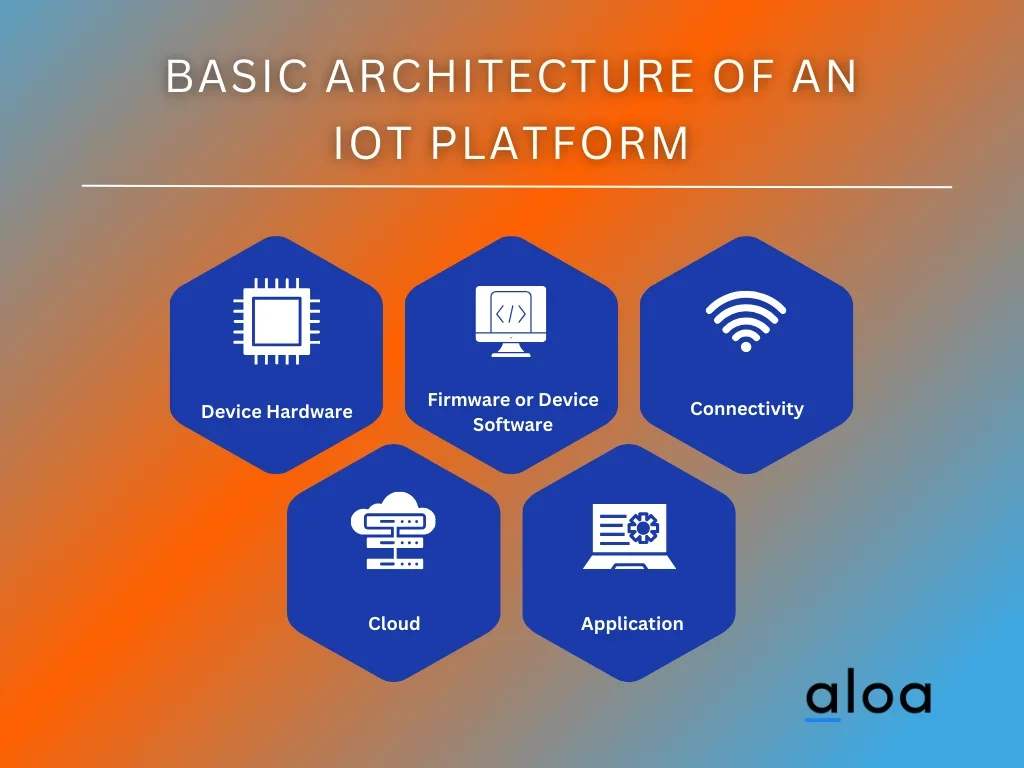
Device Hardware
At the foundation of any IoT system is the device hardware. These physical components—sensors, actuators, and other electronic devices—interact with the environment. In healthcare, for instance, IoT device hardware can range from wearable fitness trackers to advanced medical devices monitoring patient vitals in real time. These devices collect critical data from their surroundings, which is then processed and analyzed for actionable insights.
Firmware or Device Software
The firmware or device software forms the bridge between the device hardware and the software capabilities of an IoT platform. This embedded software runs directly on the IoT device, controlling its functions and enabling it to communicate with other devices or the cloud. It's what allows a thermostat in a smart home to adjust the temperature based on user preferences or a heart rate monitor in a healthcare setting to alert medical staff when a patient's vitals go beyond normal ranges.
Connectivity
Connectivity is the lifeline of an IoT platform, enabling devices to send the data they collect to the cloud or directly to other devices. This can be achieved through various communication protocols like Wi-Fi, Bluetooth, Zigbee, or cellular networks. The choice of connectivity method depends on the specific requirements of the IoT application, such as range, power consumption, and data transfer rates. In real estate, for instance, IoT devices might use long-range, low-power solutions to monitor and manage properties efficiently.
Cloud
The cloud component of an IoT platform is where the heavy lifting happens. It's a powerful, scalable computing resource that processes, analyzes, and stores data received from IoT devices. This cloud infrastructure enables the integration of complex analytics and machine learning algorithms, turning raw data into meaningful insights. For healthcare IoT devices, the cloud can analyze vast amounts of data from multiple sources, identifying trends and potential health issues before they become critical.
Application Layer
The application layer is where the end-users interact with the IoT system. It can be a web-based dashboard, a mobile app, or a software interface that presents the processed data in an understandable and actionable format. In IoT trends in healthcare, applications allow patients and healthcare providers to monitor health metrics in real time, improving patient outcomes. IoT in real estate applications enables property managers and tenants to control smart building features for enhanced comfort and efficiency.
How To Develop an IoT Platform
Developing an IoT platform involves a series of strategic steps to ensure it can efficiently manage and analyze data from various IoT devices. Below is a detailed roadmap to guide you through creating an IoT software platform that meets your target audience's needs and leverages IoT technology's full potential.
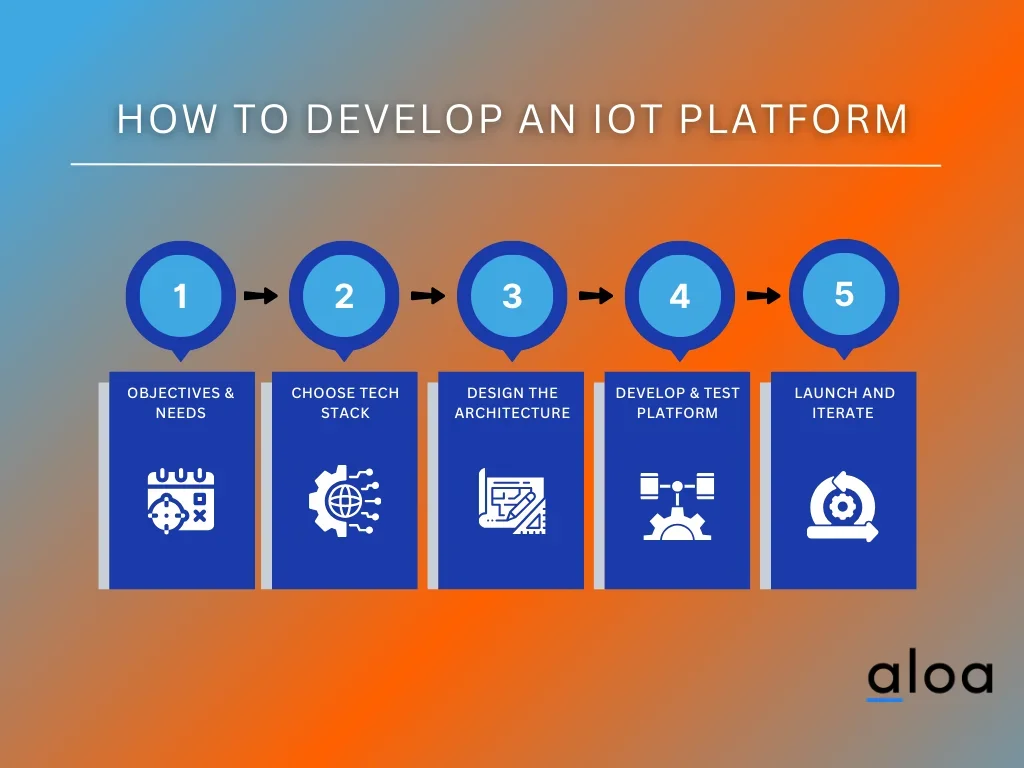
Step 1: Define Your Objectives and Requirements
Creating an effective IoT platform begins with a clear vision. Understanding what you aim to achieve and who you're building for sets the foundation for a successful platform. This step is about laying down the goals and scope and identifying the needs of your target users.
- Identify the Purpose: Establish what the platform intends to accomplish, aligning it with your business goals or societal needs.
- Determine the Scope: Define the extent of device compatibility and data handling capabilities, planning for scalability from the outset.
- Understand Your Audience: Deep dive into the requirements of your users to ensure the platform meets their expectations and solves their problems.
Having a well-defined objective and a comprehensive understanding of your requirements and target audience forms the bedrock of your IoT software platform. This clarity guides the subsequent steps, ensuring your development efforts align with your goals.
Step 2: Choose the Right Technology Stack
Selecting the appropriate technology stack is critical in determining how well your IoT software platform performs, scales, and evolves. This step involves choosing hardware and software and ensuring compatibility with IoT protocols to create a robust and flexible platform.
- Select the Hardware: Identify compatible devices and ensure your platform can communicate with them effectively.
- Pick the Software Tools: Opt for software components that offer reliability and efficiency and suit the needs of your platform.
- Ensure Compatibility: Guarantee your platform can operate with various IoT protocols, ensuring broad device support and interoperability.
The technology stack you choose lays the groundwork for the functionality and future-proofing of your IoT software platform. A reasonable selection ensures your platform meets current demands and is prepared for future advancements.
Step 3: Design the Architecture
Crafting the architecture of your IoT platform is about more than just technical specifications; it's about envisioning the framework that will support your platform's operations, scalability, and security. This step requires a balance between flexibility and robustness.
- Modular Design: Implement a design that allows for easy adjustments and additions, accommodating the evolving nature of IoT.
- Focus on Scalability: Ensure your architecture can grow with your user base and device connections without compromising performance.
- Incorporate Security Measures: Embed security at every layer of your platform to protect against threats and ensure user trust.
A well-thought-out architecture is the backbone of any successful IoT software platform. It supports current functionality and anticipates future expansions and challenges, ensuring longevity and reliability.
Step 4: Develop and Test the Platform
The development phase is where your IoT software platform takes shape. You can iteratively build and refine your platform through agile methodologies, ensuring it meets your objectives and user needs. Testing is integral to this process, helping to identify and rectify any issues early on.
- Agile Development: Adopt an iterative approach to development, allowing for flexibility and continuous improvement.
- Testing: Conduct extensive testing to ensure reliability, usability, and security across all components of your platform.
- User Feedback: Involve users early in the testing phase to gain valuable insights and make necessary adjustments.
Development and testing are cyclical processes that refine your IoT software platform into a robust, user-centric solution. This iterative approach ensures the platform meets and exceeds user expectations and industry standards.
Step 5: Launch and Iterate
Launching your IoT platform is a significant milestone, but it's just the beginning of its lifecycle. The launch phase is an opportunity to learn from real-world use, gather feedback, and plan for ongoing improvements.
- Soft Launch: Begin with a limited release to monitor the platform's performance in a controlled environment closely.
- Iterate Based on Feedback: Use the insights gathered from your initial users to refine and enhance the platform.
- Scale and Expand: Look for opportunities to grow your platform's capabilities and reach as it matures.
The launch is not the end but a new phase where your IoT software platform continues to evolve. Ongoing iteration based on user feedback and technological advancements ensures that your platform remains relevant and continues to provide value to its users. This continuous cycle of improvement and expansion ultimately defines the success of an IoT software platform in the ever-evolving landscape of technology.
IoT Platform Use Cases
The Internet of Things transforms how we interact with the world around us, making our environments smarter, more efficient, and incredibly interconnected. The IoT software platform is a crucial framework that enables the seamless integration, management, and analysis of countless IoT devices.
Here, we explore ten pivotal IoT platform use cases, showcasing their versatility and impact across various sectors.
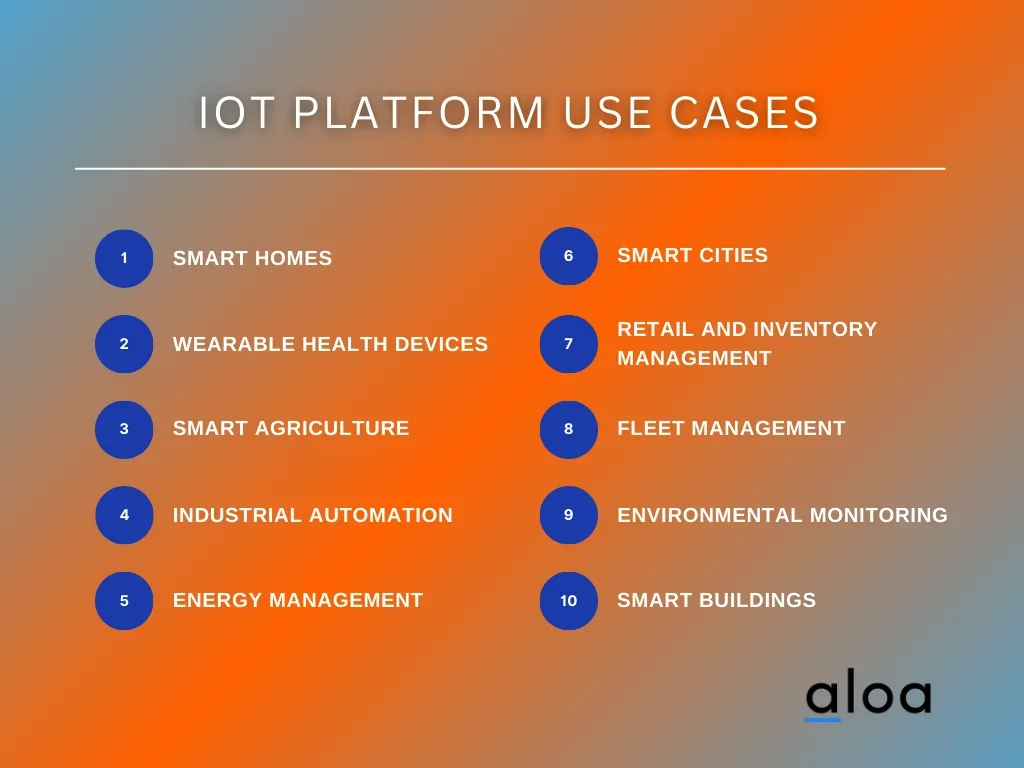
- Smart Homes: The platform revolutionizes home environments by enabling communication devices like thermostats, security cameras, and lights. Users can automate tasks, enhance security, and improve energy efficiency through a centralized IoT overview.
- Wearable Health Devices: These platforms collect and analyze data from wearable devices in the healthcare sector, providing real-time health monitoring and insights. This use case highlights the platform's role in preventive healthcare by tracking vital signs and detecting anomalies early.
- Smart Agriculture: The platforms are pivotal in agriculture, monitoring soil moisture, weather conditions, and crop health. Farmers can make informed decisions, optimize resources, and increase crop yields by analyzing this data.
- Industrial Automation: In manufacturing, IoT solutions facilitate the automation of production lines, machinery maintenance, and inventory management. They enhance operational efficiency, reduce downtime, and predict maintenance needs.
- Energy Management: It enables smart grids and energy management systems to monitor and control energy usage in real-time. This application not only reduces costs but also promotes sustainable energy consumption.
- Smart Cities: Urban development benefits significantly from IoT solutions, which manage traffic flow, public transportation, and waste management systems. They improve city living by reducing congestion, enhancing public safety, and promoting environmental sustainability.
- Retail and Inventory Management: IoT software platforms optimize inventory management and enhance the customer shopping experience in the retail sector. They track inventory levels, automate ordering processes, and enable personalized marketing strategies.
- Fleet Management: It offers comprehensive solutions for managing vehicle fleets, tracking their location, monitoring fuel consumption, and ensuring driver safety. This use case demonstrates the platform's role in improving logistics and reducing operational costs.
- Environmental Monitoring: By deploying sensors across various environments, IoT software platforms monitor air and water quality, detect pollutants, and track wildlife. This application is crucial for conservation efforts and environmental protection.
- Smart Buildings: IoT platform solution transforms commercial buildings into smart facilities, optimizing energy usage, improving security, and enhancing occupant comfort. They automate lighting, heating, and air conditioning systems to create efficient and sustainable workspaces.
Key Takeaway
Understanding the concept of an IoT platform is crucial for startups, businesses, and software developers aiming to leverage the power of the Internet of Things. An IoT software platform facilitates seamless integration, management, and analysis of devices, offering comprehensive insights that drive innovation and efficiency. The benefits of IoT solutions are immense for startups and businesses looking to thrive in the digital age. These platforms streamline operations and open new avenues for growth and customer engagement.
Aloa's dedication to delivering cutting-edge insights and solutions in IoT and other emerging technologies is a testament to our commitment to your success. Aloa is your partner in navigating the complexities of the IoT ecosystem, ensuring you harness its full potential for unparalleled advancement. Explore our blog for a thorough IoT overview and discover how an IoT platform can transform your business landscape.

